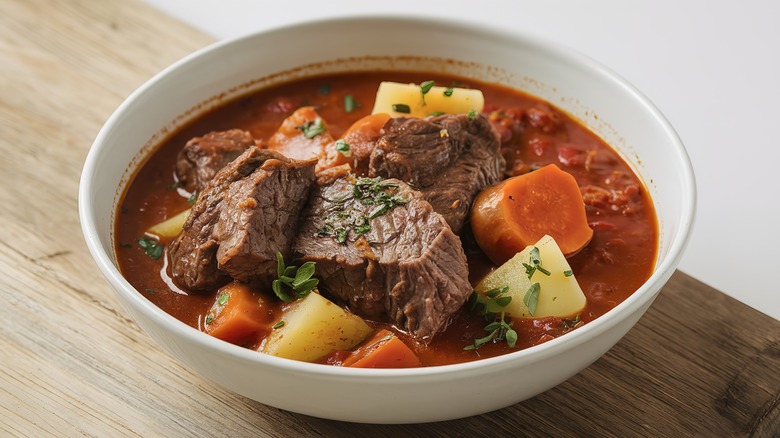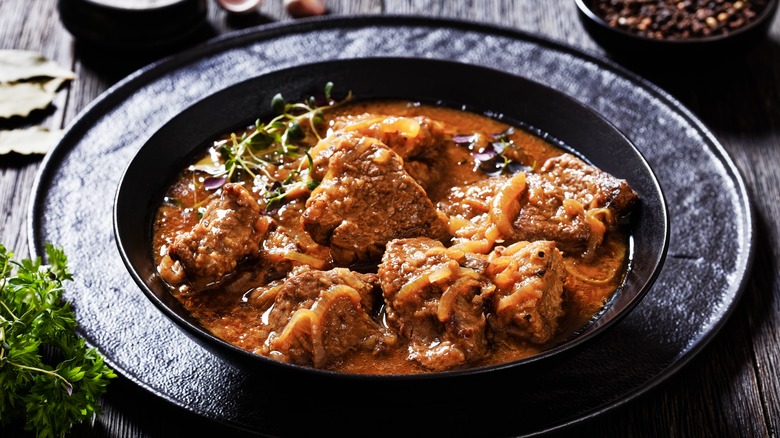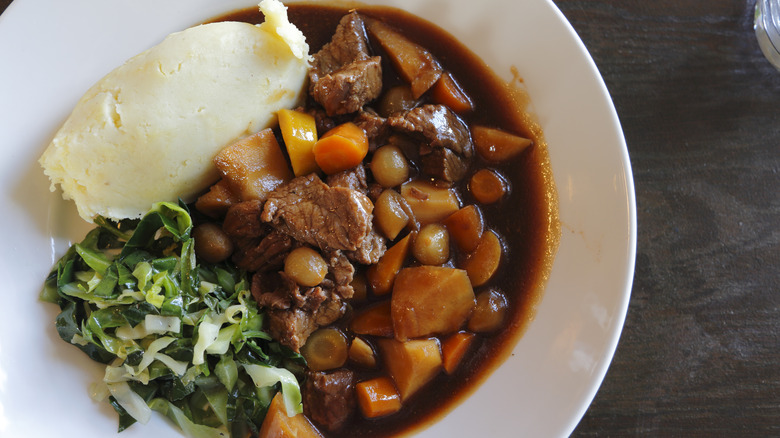What Makes Carbonade Valdostana Different From Beef Stew?
There's a special kind of satisfaction in slow-cooked meat dishes. Full of moisture, rich in beefy flavor, and fall-off-the-bone tender, they're a delectable assortment of tastes. Such a cooking method is employed in many cuisines, which means there's a broad range of stewed dishes to select from. And such variety means it's easy to get lost in the sauce (sometimes literally) of dish differences.
Take carbonade valdostana, a regional favorite from Northern Italy. Combining salted beef chunks with a bouquet of alpine aromatics and red wine, it's a dreamy kind of chalet dinner. If you're lucky to be served a plate over buttered up polenta, it will probably make an American-style stew with potatoes feel like a different world. But despite the distinct flavor palate, carbonade valdostana does fall under the beef stew umbrella. The meaty dish is slow-cooked in a liquid, so it fits squarely into the style. However, the beauty of the beef stew variety is revealed in its flavor nuances.
What is carbonade valdostana?
This beef stew recipe hails specifically from Northwest Italy. Located by the French and Swiss border, the cuisine in this area draws heavily from more northern areas. So the fact its name is shared with the popular Belgian beef stew carbonnade is no coincidence. While this Flemish dish employs beer, onions, and herbs for flavor, carbonade valdostana shifts to an Italian palate.
For one, carbonade valdostana uses red wine, a commonality it shares with French-style beef stews. Furthermore, the seasoning ingredients reflect the mountainous surroundings, like juniper berries, rosemary, sage, cloves, cinnamon, nutmeg, and cloves. And this Italian version is traditionally made with a beef that's salt cured. While such a practice is no longer mandatory for the dish, some chefs choose to create a similar marinated consistency by seasoning the beef with salt and flavors for a day prior.
Even within this particular Italian region, there's further variety with the dish. Seasonings change from village to village, and a few even use beer, like in Belgium. A particularly noted distinction is in how the meat is cut — some slice it, while others chop it into strips. Otherwise, carbonade valdostana follows an assembly akin to other beef stews. Collagen-rich cuts like rump are slow simmered to tender perfection. And in Italian style, it's all served over polenta, which you should consider making in your rice cooker.
What is beef stew?
In the most stripped down definition, a beef stew consists of slow-cooked meat in a liquid. The dish reaches for tougher cuts of meat, full of collagen for tenderness and some fat for flavor. These pieces of beef are sourced from all across the cow, with varieties like chuck flap especially adding richness to beef stew preparations. Such cuts are a crafty way of turning cheaper meats into delicious results, hence their appearance in a wide variety of cuisines.
Seasonings run the gamut of possibilities. For Americans, a classic beef stew contains large meat chunks married with root vegetables and a melange of savory sauces. Meanwhile, Greek-style stifado melds beef with tomato, wine, and spices. And in Mexico, you'll find a beef stew called carne guisada, which is flavored with chile peppers, garlic, and cumin. Across renditions, slow-cooking liquid is varied too — broth, wine, and beer all appear as the foundation of the beef stew.
Although the dish comes in many forms, there are some common mistakes to avoid when making beef stew. You'll want to select the right beef cut, sear it, season liberally, and cook it in a liquid other than water to ensure a flavorful result. The secret in converting the connective tissues into rich and moist gelatin — the rest is just a matter of adding the right flavorings. So simmer slowly, but don't overcook, and the pleasures of the dish reveal themselves.


